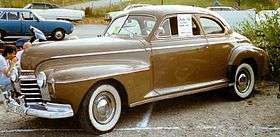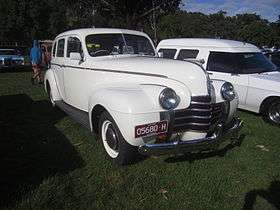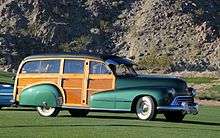Oldsmobile Series 60
| Oldsmobile Series 60 | |
|---|---|
 1941 Oldsmobile Series 60 Coupé | |
| Overview | |
| Manufacturer | Oldsmobile (General Motors) |
| Production | 1938–1948 |
| Body and chassis | |
| Class | Full-size car |
| Layout | FR layout |
| Platform | A-body |
The Series 60 is a full-size car made by Oldsmobile from the 1939 through the 1948 model years.
1939–1940
| First generation | |
|---|---|
 1940 Oldsmobile Series 60 Sedan | |
| Overview | |
| Model years | 1939–1940 |
| Assembly |
South Gate, California Lansing, Michigan Linden, New Jersey |
| Designer | Harley Earl |
| Body and chassis | |
| Body style |
2-door Business coupe 2-door Club coupe 2-door Sedan coupe 4-door sedan 2-door convertible 4-door station wagon |
| Related |
Pontiac Deluxe Chevrolet Special Deluxe Chevrolet Master Deluxe Chevrolet Master 85 |
| Powertrain | |
| Engine |
215 cu in (3.5 L) Oldsmobile I6 230 cu in (3.8 L) Oldsmobile I6 |
| Transmission |
3-speed synchromesh manual 4-speed Hydra-Matic automatic |
| Dimensions | |
| Wheelbase |
1939: 115.0 in (2,921 mm) 1940: 116.0 in (2,946 mm) |
| Length |
1939: 189.0 in (4,801 mm) 1940: 197.8 in (5,024 mm) |
| Height |
1939: 66.0 in (1,676 mm) 1940: 65.0 in (1,651 mm) |
| Curb weight | 3,100–3,700 lb (1,400–1,700 kg) |
Naming standards were in flux at Oldsmobile during the late 1930s and 1940s. From 1932 through 1938 Oldsmobile had two series: "F" and "L" including the 1937-1938 Oldsmobile 6 cylinder engine. Series F came with a straight-6 engine and Series L came with a larger body and a straight-8 engine. Series F was renamed Series 60 in 1939 and Series L was replaced with the Series 70 and 80, with the Series 70 and 80 being powered by the straight-6 and the straight-8 respectively. The Series 60 used the GM A-body and the Series 70 and 80 used the B-body.
The Series 60 occupied the entry-level position for Oldsmobiles sold in the United States from 1939 through the 1948 model years.[1] They were trimmed in an entry level fashion and, in parts and components, the Series 60 models were closely related to Chevrolet and junior Pontiacs.
The 1939 Oldsmobiles were available with the "Safety Automatic Transmission" and not with the Hydramatic. The safety automatic transmission was semi-automatic, in that it still used a clutch to get the car going and then shifted automatically. The Hydramatic Transmission, a fully, clutchless automatic transmission debuted in the 1940 model year.
In 1939 four body styles were available: a Business Coupe with no rear seat, a Club Coupe with two rear fold-away jump seats, a 2-door Sedan with a full rear seat and a 4-door Sedan which shared its roofline with the 2-door Sedan. The wheelbase was 115 inches.[1] The back of the front seats were rounded and padded for protection of the rear seat occupants.[2] A 216CID 90 hp (67 kW) I6 was used.[3]
In 1940 the even larger C-body was introduced to Oldsmobile and it alone was powered by the straight-8. In order to differentiate it from the previous year's Series 80 it was named Series 90 (there was no Series 80 that year). The series were also given names for the first time that year with the Series 60, 70, and 90 being called the Special, Dynamic, and Custom Cruiser respectively.
Two body styles were added to the model line up in 1940: a 2-door convertible and a 4-door station wagon. In addition a full rear seat was added to the Club coupe although it still did not share the roofline of the somewhat roomier 2-door Sedan. A Deluxe equipment package was also new this year.
1941–1948
| Second generation | |
|---|---|
.jpg) | |
| Overview | |
| Model years | 1941–1948 |
| Assembly |
South Gate, California Atlanta, Georgia Kansas City, Kansas Framingham, Massachusetts Lansing, Michigan Linden, New Jersey |
| Designer | Harley Earl |
| Body and chassis | |
| Body style |
2-door Business coupe 2-door Club coupe 2-door Sedan coupe 2-door Club Sedan coupe 4-door sedan 2-door convertible 4-door station wagon |
| Layout | FR layout |
| Platform | A-body |
| Related |
Pontiac Torpedo Chevrolet Special Deluxe Chevrolet Master Deluxe Chevrolet Fleetline Chevrolet Fleetmaster Chevrolet Stylemaster |
| Powertrain | |
| Engine |
238 cu in (3.9 L) Oldsmobile I6 257 cu in (4.2 L) Oldsmobile I8 |
| Transmission |
3-speed synchromesh manual 4-speed Hydra-Matic automatic |
| Dimensions | |
| Wheelbase | 119.0 in (3,023 mm) |
| Length | 204.0 in (5,182 mm) |
| Curb weight | 3,300–4,000 lb (1,500–1,800 kg) |
In 1941 both engines were offered on each Oldsmobile series so to differentiate between the two the second digit was used to denote the number of cylinders, so the Special 60 was replaced with the Special 66 and 68. And in fact the only way to get an 8-cylinder engine on the GM A body from 1941 to 1948 was to buy an Oldsmobile Special 68 or a Pontiac Deluxe Torpedo Eight. In a sense these were perhaps the first muscle cars.
In 1941, the Series 60 wheelbase was increased to (119 in). Two models were produced, the 66 which used a 238 in3 (3.9 L) straight-6 engine and the 68 which used a new 257CID 110 hp (82 kW) straight-8.[1] All series 60s came with a three-speed column shift manual, or the optional four-speed Hydramatic automatic. Both options could be paired with either engine choice. Because of the column shift and new wider runningboard-less "torpedo" styling three passengers could now be accommodated comfortably in front. It used full instrumentation.[4]
In 1941 the lineup consisted of a 3-passenger two-door Business Coupe without a rear seat, a 6-passenger two-door Club Coupe with a rear seat, a 2-door Sedan, a 4-door "bustle back" Sedan which shared its roof line with the 2-door Sedan, a 4-door 8-passenger wood bodied station wagon (a.k.a. "Woodie") and a 3-passenger 2-door convertible. Except for the convertible and station wagon, all were available in either Standard or Deluxe trim.
In 1942 Oldsmobile stayed with its Special 60 series on the bottom of a three series format. As with all automakers production was halted early in the year due to the war. Both a six or eight-cylinder motor could be ordered. Extremely rare, both a convertible or a station wagon were available. A new body style was a 6-passenger 2-door Club Sedan fastback.
In 1946 the Special 60 series was again Oldsmobile's lowest priced group of cars. Special 60s had only 6-cylinder power, wlthough an 8-cylinder was offered in other years. The Business Coupe and the 2-door Sedan were discontinued. Interiors were a tan mixture pattern cloth. Standard tire size was 6.00 x 16 inches. Leather interiors were offered on convertibles. Technical features included electro hardened aluminum pistons, full-pressure lubrication and automatic choke with fast idle mode. In 1946, dual windshield wipers were standard.[5]
In 1947 more models were offered on the low-priced Special 60 series than the other two Oldsmobile series. The 8-cylinder engine returned to the Special 60 series and there were again 66 and 68 versions of each body style offered. Standard equipment included: safety glass, spare wheel and tire, dual horns, vacuum booster pump and cigarette lighter. The standard interior fabric was tan mixture cloth. Standard tire size was 6.00 x 16 inches. Horsepower grew to 100 for the six and 110 for the eight.[6] It also had a 37 ft (11 m) turning circle.[7]
The 66 and 68 were renamed the Dynamic 66 and 68 in 1948. The Dynamic 60 series were the smallest Oldsmobiles available and offered the greatest variety or body styles. Either 6-cylinder or 8-cylinder engines were available and were designated 66 or 68. Standard 60 Series equipment included: dual horns, dual sun visors and a cigarette lighter. The Deluxe equipment package added foam rubber seat cushions, Deluxe steering wheel, Deluxe instrument cluster, clock and chrome wheel trim rings. Standard tires were 6.00 x 16 inches. Upholstery was Bedford cord or broadcloth.
The Series 60 model designation was retired after 1948, the L-head six-cylinder was then increased in displacement to 257 cu in (4.2 L) and was used only in the Oldsmobile 76 which was discontinued in 1950. A limited amount were put through production in 1950 but only 5 exist today


Australian production
The Series 60 was also produced from 1946 to 1948 by General Motors-Holden's in Australia, where it was marketed as the Oldsmobile Ace.[8] Local bodies were fitted and these cars are completely different from the scuttle back and were the last GM cars to feature "suicide doors" (hinged at the back).
South African production
Cars were exported to South Africa in complete knock down (CKD) form for local assembly.
References
- 1 2 3 Kimes, Beverly (1996). standard catalog of American Cars 1805–1942. Krause publications. ISBN 0-87341-428-4.
- ↑ "Directory Index: Oldsmobile/1939_Oldsmobile/1939_Oldsmobile_Brochure". Oldcarbrochures.com. Retrieved 2011-11-09.
- ↑ "Directory Index: Oldsmobile/1939_Oldsmobile/1939_Oldsmobile_Brochure". Oldcarbrochures.com. Retrieved 2011-11-09.
- ↑ "Directory Index: Oldsmobile/1940 Oldsmobile/1940_Oldsmobile_Operating_Guide". Oldcarbrochures.com. Retrieved 2011-11-09.
- ↑ Gunnell, John A. (ed.). Standard Catalog of American Cars 1946–1975. krause publications. ISBN 0-87341-027-0.
- ↑ Flory, Jr., J. "Kelly" (2008). American Cars, 1946–1959 Every Model Every Year. McFarland & Company, Inc., Publishers. ISBN 978-0-7864-3229-5.
- ↑ "Directory Index: Oldsmobile/1947 Oldsmobile/1947_Oldsmobile_Foldout". Oldcarbrochures.com. Retrieved 2011-11-09.
- ↑ The Oldsmobile "ACE" - 1946 to 1948, www.oldsmobileclub.org.au Retrieved 29 July 2015
| Oldsmobile road car timeline, Post WW2–1970s — next » | ||||||||||||||||||||||||||||||||||
|---|---|---|---|---|---|---|---|---|---|---|---|---|---|---|---|---|---|---|---|---|---|---|---|---|---|---|---|---|---|---|---|---|---|---|
| Type | 1940s | 1950s | 1960s | 1970s | ||||||||||||||||||||||||||||||
| 6 | 7 | 8 | 9 | 0 | 1 | 2 | 3 | 4 | 5 | 6 | 7 | 8 | 9 | 0 | 1 | 2 | 3 | 4 | 5 | 6 | 7 | 8 | 9 | 0 | 1 | 2 | 3 | 4 | 5 | 6 | 7 | 8 | 9 | |
| Subcompact | Starfire | |||||||||||||||||||||||||||||||||
| Compact | F-85 | |||||||||||||||||||||||||||||||||
| Cutlass | Omega | |||||||||||||||||||||||||||||||||
| Mid-size | F-85 | F-85 | ||||||||||||||||||||||||||||||||
| Cutlass | Cutlass | Cutlass | Cutlass | |||||||||||||||||||||||||||||||
| Mid-size station wagon | Vista Cruiser | Vista Cruiser | Vista Cruiser | Cutlass Cruiser | ||||||||||||||||||||||||||||||
| Full-size | 66/68 | |||||||||||||||||||||||||||||||||
| 76/78 | 76 | |||||||||||||||||||||||||||||||||
| 88 | 88 | 88 | 88 | 88 | 88 | 88 | 88 | |||||||||||||||||||||||||||
| 98 | 98 | Ninety- |
Ninety- |
Ninety- |
Ninety- |
Ninety- |
Ninety- |
Ninety- | ||||||||||||||||||||||||||
| Full-size station wagon | 76 | 88 Fiesta | 88 Fiesta | 88 Fiesta | Custom Cruiser | Custom Cruiser | ||||||||||||||||||||||||||||
| 88 | ||||||||||||||||||||||||||||||||||
| Personal luxury | Starfire | Toronado | Toronado | Toronado | ||||||||||||||||||||||||||||||
